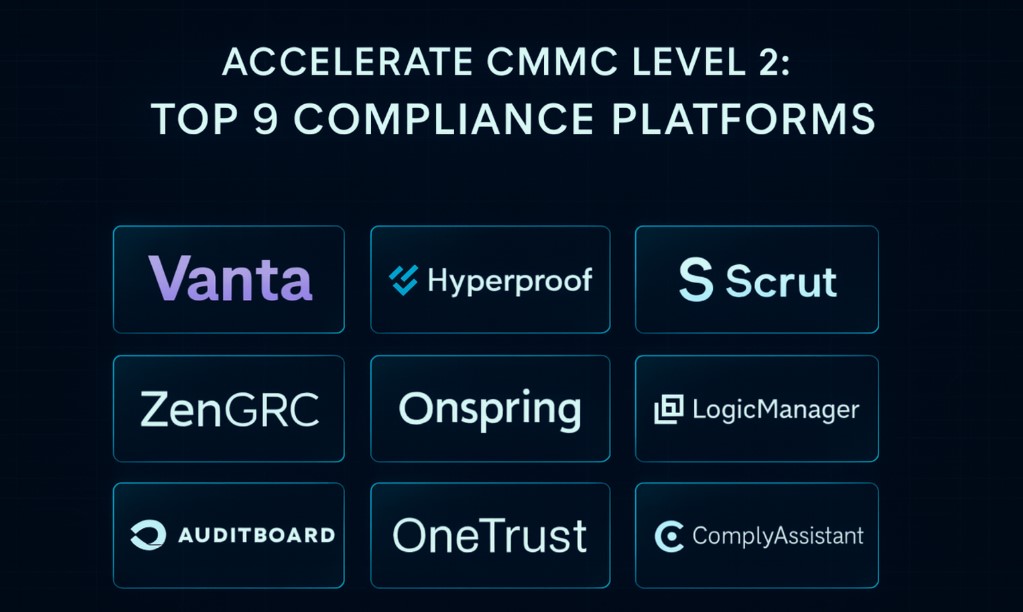Top 9 CMMC compliance software for faster DoD Level 2 audits
This guide highlights the top 9 CMMC compliance software tools designed to help contractors navigate the complexities of DoD Level 2 audits. These platforms automate gap mapping, evidence collection, and assessor collaboration, ensuring a smoother audit process and faster certification. Whether youre a cloud-first contractor or a large prime managing multiple vendors, these tools help streamline CMMC compliance and maintain audit readiness year-round.
Landing a Department of Defense contract now takes more than sharp pricing—it takes proof. It is estimated that nearly 338,000 contractors and subcontractors will be subject to the CMMC 2.0 program under the microscope, and starting November 10, 2026, a certified third-party must sign off on applicable Level 2 bids. Miss the mark, and your proposal stops cold.
This guide ranks nine platforms that automate gap mapping, real-time evidence capture, and assessor collaboration so you can sail through Level 2—and keep winning work.
CMMC 2.0 level 2 in a nutshell
CMMC 2.0 trims the old five-tier model to three. Level 2 protects Controlled Unclassified Information by requiring contractors to implement all 110 security controls across 14 NIST 800-171 families.
The scale is sizable: it is estimated that nearly 338,000 contractors and subcontractors will be subject to the CMMC 2.0 program. Unlike Level 1, you cannot self-attest. A certified third-party assessment organization (C3PAO) will review your evidence, interview your team, and record the verdict, and the Pentagon adds that requirement to new solicitations on November 10, 2025.
Most teams need 9–12 months to reach Level 2, a timeline echoed by Vanta, which notes that the bulk of that effort comes from writing policies, closing gaps, and building a defensible System Security Plan. Along the way, contractors also have to capture real-time evidence, track Plans of Action and Milestones, and coordinate across IT, security, and subcontractors.
The takeaway: Level 2 is an ongoing operating program, not a one-off checklist. The nine tools ahead help you keep that program running smoothly.
Why software is the fast track
Spreadsheets and shared folders can’t keep pace with 110 controls, nonstop evidence requests, and surprise audits. That pressure explains why Gartner predicts compliance teams will raise spending on GRC tools by 50 percent by 2026.
Purpose-built platforms solve three core problems at once: they connect to your tech stack, capture screenshots and logs in real-time, and show each control’s status on one dashboard. When you shortlist vendors, see Vanta's guide on compliance management for a side-by-side comparison of automation depth, integrations, and AI that accelerate remediation.
A solid CMMC tool will:
-
Map your environment against all 110 NIST 800-171 controls the first day you log in.
-
Auto-collect and tag fresh evidence so the screenshot hunt is over.
-
Track every POA&M with owners, due dates, and progress metrics the assessor can verify.
-
Let your C3PAO review artifacts in a secure portal, removing the need for zip files.
When software tackles those chores, your team can focus on remediation instead of paperwork and stay audit-ready even when an assessor arrives unannounced.
How we picked the top platforms
According to a recent PwC survey, nearly 90% of respondents said their ability to implement and maintain IT systems and data is being negatively impacted by increased compliance complexity, driving investment in compliance technology. So we treated our evaluation like an audit, we started with 24 CMMC-focused tools from G2, Capterra, and industry webinars and measured each one against four filters:
-
Automation depth. The platform must pull configurations, logs, and screenshots without manual uploads, cutting clicks and audit risk.
-
NIST mapping and readiness. Each tool needs a complete library of the 110 Level 2 practices, plain-language guidance, and one-click gap analysis.
-
Assessor ecosystem. Vendors earn points when a C3PAO can log in, request evidence, and track questions in real time. Familiar UI speeds certification.
-
Evidence workflow coverage. Broad integrations, role-based access, POA&M tracking, and drift alerts keep every stakeholder aligned.
Only nine platforms passed all four filters. They earned a closer look and, we think, a demo spot on your calendar.
9 best CMMC compliance software platforms in 2026
Nine platforms cleared every filter. We rank them from the most automated to the most budget-friendly so you can find the right fit fast.
1. Vanta: all-in-one automation for level 2
Vanta leads because it automates tasks most teams still perform manually. Its CMMC compliance software connects to 375+ cloud, identity, and endpoint systems and centralizes evidence collection for Level 2.
The dashboard flags every CMMC control in red, yellow, or green. Unmet items appear with plain-language fixes and pre-assigned owners, turning a typical 6–12-month prep cycle into a focused sprint.
Auditors receive a read-only portal. Instead of trading zip files, your C3PAO can browse evidence, leave comments, and close requests in real time, cutting email lag and speeding certification.
Put Vanta on your short list if you want maximum automation and an assessor experience that feels collaborative rather than combative.
2. Hyperproof: templates and continuous control testing
Hyperproof suits teams that want structure plus ongoing assurance. Your first login launches an out-of-the-box CMMC 2.0 template drawn from Hyperproof’s library of 118+ frameworks. A gap scan flags every missing policy, procedure, or technical control in minutes, so no spreadsheet mash-ups are needed.
Automation then takes over. You choose a cadence—daily, weekly, or monthly—and Hyperproof auto-pulls evidence and tests controls, sending alerts the moment drift appears. Think of it as an always-on radar that spots issues long before a C3PAO does.
Collaboration stays orderly: tasks fall into each owner’s queue with due dates and reminders, and one-click SSP reports supply the audit-ready paper trail assessors expect. If you want continuous control of health without constant nagging, Hyperproof is worth a closer look.
3. Scrut Automation: smart GRC with cloud security monitoring
Scrut is built for cloud-first contractors. Its dashboard unifies compliance, risk, and cloud posture in one view, letting you toggle between CMMC controls and AWS misconfigurations without changing tabs.
Under the hood, Scrut checks your cloud against more than 230 CIS benchmarks every day and maps each finding to the matching CMMC practice. That tight coupling lets lean teams close technical gaps while polishing policy gaps, no context-switching required.
Evidence follows the same playbook: Scrut pulls configuration data, tags it to the right control, and stores it in a portal your assessor can review securely. Drift alerts appear the moment a setting slips, turning potential audit findings into quick-hit tickets.
If most of your infrastructure lives in AWS, Azure, or Google Cloud and your compliance team numbers in single digits, Scrut delivers clarity and speed without the steep learning curve of heavier GRC suites.
4. Reciprocity ZenGRC: mature GRC with strong documentation workflow
ZenGRC brings structure to sprawling evidence libraries. Its version-controlled document vault stores every policy, procedure, and screenshot with edit history and approvals, so an assessor can pull last quarter’s incident-response plan in seconds.
The platform ships with a library of more than 25 regulatory and industry frameworks cross-mapped to CMMC controls. Start a self-assessment, push the questionnaire to business owners, and watch answers flow into a live readiness scorecard that surfaces gaps automatically.
Workflow keeps momentum. ZenGRC assigns tasks, nudges control owners, and logs evidence against each requirement, while dashboards slice progress by domain so leadership sees where to focus effort.
ZenGRC suits teams that juggle multiple frameworks or need an audit trail auditors can trust.
5. Onspring: flexible platform with supply-chain compliance tracking
Onspring thrives in complex environments. Its no-code builder lets you add new fields, forms, and dashboards in minutes with no tickets to IT, a plus when you need to track subcontractor certification status or add a POA&M field on the fly.
The same flexibility extends downstream. Onspring keeps a live registry of suppliers, their latest CMMC scores, and renewal dates, letting you spot weak links before they derail a bid. Inside your walls, each CMMC practice lives as a record with an owner, status, and evidence log, ready for the assessor.
Onspring's CMMC Management software is estimated to generate 70% savings in time by automating the control testing and POA&M processes. If you’re a large prime juggling many teams and vendors, Onspring turns sprawling requirements into a program you can steer with confidence.
6. LogicManager: risk-driven compliance with incident tracking
LogicManager treats every CMMC control as a risk to score and mitigate. Impact and likelihood ratings push you toward the highest-exposure gaps first, not just the easiest fixes.
POA&Ms stay front and center. Open a gap and see remediation steps, owners, budgets, and deadlines, all visible on a dashboard that shows exactly how many POA&Ms remain against the Pentagon’s 180-day clock.
An integrated incident module closes the loop. Record a security event, capture root-cause analysis, and tie corrective actions back to the CMMC practice they improve. With more than 500 integrations in its hub, LogicManager also pulls evidence from tools you already use, cutting swivel-chair time.
LogicManager suits teams that want risk analytics, POA&M discipline, and incident response in one platform.
7. AuditBoard: end-to-end audit workflow for CMMC
Built by former auditors, AuditBoard guides you through scoping, planning, fieldwork, and reporting in one continuous flow, so nothing stalls between phases. Its CrossComply module supports more than 30 frameworks and more than 200 integrations, mapping CMMC practices to policies, diagrams, and evidence in a single view. Select AC.2.013 and you’ll see the access-control policy, network diagram, and attestation side by side, ready for your assessor’s request.
Requests travel as structured tasks instead of email threads. Stakeholders upload evidence, auditors mark it complete, and any finding automatically turns into an issue with linked remediation steps. Executives watch a real-time dashboard of open items without digging through jargon.
If your team already runs SOX or ISO audits on AuditBoard, adding CMMC takes a single toggle. New users also gain a disciplined workflow that turns a Level 2 audit into a predictable project.
8. OneTrust: comprehensive platform with guided CMMC workflow
OneTrust brings serious scale to CMMC readiness, serving more than 14,000 customers, including 75 percent of the Fortune 100. Launch the Trust Intelligence console, and an in-app wizard walks you through every Level 2 practice in plain English. You answer, attach evidence, and a gap report flags high-risk areas in minutes.
Next come task lists. Each action includes step-by-step guidance (tighten multifactor authentication, update logging, and so on), an owner, and a deadline. Progress feeds a live dashboard that leadership can scan without decoding jargon.
Because OneTrust also houses risk, vendor, and privacy modules, you can see how CMMC controls intersect with third-party security and data-protection laws in one view instead of three separate tools. If you need guided workflows at enterprise scale, OneTrust provides an auditable roadmap from sysadmins to legal.
9. ComplyAssistant: user-friendly CMMC compliance tracking
ComplyAssistant shows you don’t need a six-figure budget to run a disciplined CMMC program. A built-in self-assessment scores each practice as high, medium, or low risk, so you spot the hottest issues in less than 10 minutes.
Every gap converts into a Kanban-style task card with an owner and a due date. Move a card to Done, and the progress bar edges toward full compliance, motivating lean teams tackling Level 2 for the first time.
ComplyAssistant integrates with essentials like Microsoft 365, Azure AD SSO, Jira, and ServiceNow, capturing real evidence without complex setup. Advisors and assessors can log in alongside you, keeping feedback and artifact reviews in one hub instead of scattered email threads.
For small contractors that want guidance, accountability, and clarity at an approachable price, ComplyAssistant delivers a complete toolkit.
Conclusion
Level 2 under CMMC 2.0 isn’t a one-time push—it’s an operating program you have to run every day. The nine platforms above all help you do the hard, boring parts faster: map every NIST 800-171 control, collect defensible evidence continuously, keep POA&Ms on track, and collaborate with your C3PAO without email chaos.
Pick the tool that matches your reality: heavy automation and assessor portals if you’re time-boxed, cloud posture visibility if you’re AWS/Azure-first, supply-chain tracking if you’re a large prime, and budget-friendly tasking if you’re a lean subcontractor. If you can automate 70–90% of evidence collection and keep a clean, living SSP, Level 2 becomes an achievable project—then a repeatable habit that protects revenue long after certification day. For broader tools beyond CMMC, check out our curated compliance management software guide.
Quick next steps
Shortlist 3 vendors that best match your size/stack.
Run a 14-day pilot on a limited scope (e.g., AC + AU families).
Validate integrations (SSO, cloud, endpoints) and test an end-to-end assessor workflow with sample artifacts.
Lock a remediation plan and POA&M burn-down against your November 10, 2025 target.
Freqenlty Asked Questions (FAQs):
1. What is CMMC 2.0 Level 2?
Answer: It’s the full set of 110 NIST SP 800-171 practices across 14 families to protect CUI—requires third-party certification (no self-attest).
2. Who needs a C3PAO assessment and when?
Answer: Any org handling CUI on solicitations that require Level 2. DoD begins adding the third-party requirement to new bids on November 10, 2025.
3. How long does Level 2 readiness take?
Answer: Typically 9–12 months, depending on current maturity, staffing, and scope.
4. What evidence actually satisfies auditors?
Answer: Time-stamped configs, logs, screenshots, user/access lists, policies with version history, training records—each mapped to specific controls and kept fresh.
5. How do these platforms speed certification?
Answer: They integrate with your stack to auto-collect evidence, continuously test controls, track POA&Ms, and let assessors review artifacts in a secure portal—cutting manual work and audit risk.

Subscribe & get all related Blog notification.





Post your comment